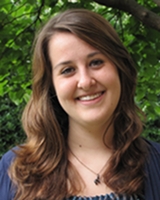2013 REU Program Participant Profiles: Kathryn Schaber

|
Major: Mathematics |
Why did you apply to the REU program?
I wanted to receive experience in epidemiology and the application of math to biological problems in order to make sure it was an area that interested me in practice as well as in theory. I hoped that this experience would help to solidify my decision to pursue graduate school in these topics.
What is the purpose of your research?
The purpose of my group's research is to create a model of feline infectious peritonitis (FIP), which is often a fatal consequence of coronavirus infection of cats and ferrts. FIP occurs when the immune system tries to fight a mutated form of a common virus in cats (FCoV). Our model will track the development of FIP in cats in catteries with the long-term goal of controlling the spread of this disease.
What does the research ultimately accomplish? What contributions to science and/or humanity does the research ultimately make?
Our research will ultimately provide a model of the development of FIP in cats in catteries. This model can be used in order to control the spread of this fatal disease that lacks a cure, thereby saving the lives of many cats that would otherwise have gotten the disease and ultimately perished.
Do you have an interesting "personal side" to your research experiences?
I volunteer at an animal shelter at school, so when I return this fall I can bring my understanding of this disease and the model we created back to shelter. I can show the other people at the shelter how to detect FIP through symptoms and how to control the spread of FIP in cats.
What were your favorite parts of the REU program?
My favorite parts of the REU program were all of the outside activities scheduled, ranging from a panel on graduate school to a trip to see the synchronous fireflies in the mountains. I feel that these activities had a perfect mix of helpfulness and fun, and they allowed me to get to know the other REU participants and mentors.
What new experiences did you gain that have helped you today?
This program gave me research experience in my chosen field, which will be invaluable when applying to graduate schools. This REU also helped me to get experience in collaborative research, something that will be very important in graduate school and beyond.
What advice would you give someone who's interested in participating in the program?
I would encourage anyone who is interested in this program to seriously look into applying, as it is definitely a great experience that will prove invaluable in terms of giving students a chance to make sure they like the field and giving the students experience in the field. I would also tell anyone who is hesitant on applying to contact the mentors of their tentative project or the program's coordinator, as everyone involved is very open to helping you with deciding your current and future plans.
Would you recommend the NIMBioS REU to others?
Yes. I believe that this program is very beneficial in providing students with experience in their chosen area of study by allowing them to apply their theoretical studies to real-life problems. The program's small group size for each individual project, highly qualified and knowledgeable mentors, as well as its opportunities to present findings allow students to get a taste of working in their chosen field.
NIMBioS
1122 Volunteer Blvd., Suite 106
University of Tennessee
Knoxville,
TN 37996-3410
PH: (865) 974-9334
FAX: (865) 974-9461
Contact NIMBioS


